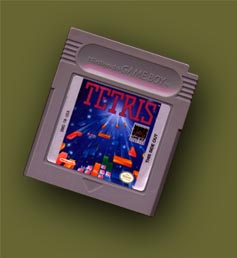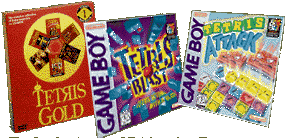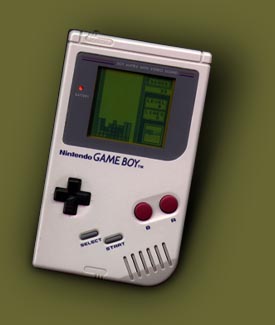THE UNOFFICIAL GAMEBOY TETRIS HOME PAGE > THEORY > TETRIS 101 > HISTORY

The game Tetris was first developed in Moscow in 1985, on a computer dubbed the Soviet Electronica-60. Later that fateful year, its creator, Alexey Pazhitnov, adapted it for players worldwide on the popular IBM PC platform; from then on, it has remained a favorite for 'gamers' of all ages and levels. Pazhitnov, then a member of the U.S.S.R. Academy of Sciences Computer Center's scientific staff, used to designed programs in the areas of speech recognition and computer aided design. However, with the success of Tetris, Pazhitnov has gone on to become a full-fledged game designer; he is creating a successful line of block-oriented puzzle games with Spectrum Holobyte, now a division of Microprose. |

Tetris creator Alexey Pazhitnov. |

The original cartridge artwork. |
Nintendo of America's Senior Vice President, Howard Lincoln, later secured rights for an adaptation for both the regular Nintendo system, as well as for their upcoming portable gaming system, tentatively called the "Gameboy".
Finally, Tetris was to be included with all Gameboy systems; much like how Super Mario Bros. and Duck Hunt were packed with the Nintendo Entertainment System's popular Action Sets, and Super Mario World with the Super NES. The Gameboy system, as well as Gameboy Tetris, debuted in September of 1989. The Nintendo version, streamlined with colorful graphics, was introduced just in time for Christmas that same year.
|
|
However, demands Wes Worthen, "Why is there no mention of the fact that the arcade version was produced by Atari Corp.? Are you against Atari and do not like
to even mention that word? Even if you are, it would still be nice to
see recognition of that fact." So, the arcade version, produced by Atari in 1987, enjoyed extreme popularity. And yes, I hate Atari.
Anyway, Tetris was a Soviet emigre that evidently conformed easily to America's capitalist system, for unsurprisingly, its popularity led to a crop of "knock-off's", most of which rarely made the transition from the PC to the Nintendo system. Welltris, in which the tetrads fall along the walls of a cube (which you looked in to), came in 1989. (I played a few rounds of Welltris myself and must voice my disappointment in the game.) After Welltris came Faces: Tris III in 1990, where apparently the object of the game was to correctly line up blocks that bear parts of a celebrity's face (i.e. Gorbachev, Yakov Smirnoff?). Wordtris premiered the following year, which appeared to be a combination of Tetris and Scrabble.
|

Tremendous variety, yet paradoxically a high degree of 'sameness'. I'd imagine it's a lot like choosing a beer. |
As if that weren't enough, in recent years came Tetris Classic and Super Tetris, the latter which evidently involves setting off bombs and finding treasures and what not. Perhaps this version is most related to Tetris II or Tetris Blast, two Gameboy sequels that came out in 1994 and 1996, respectively.
On the Nintendo/Bullet-Proof branch, Tetris Attack, a whole new game altogether, came out in September 1996 for both the Super NES and the Gameboy. Here Nintendo capitalizes on the Yoshi appeal by having Super Tetris littered with characters from Yoshi's Island. And even on the Gameboy, Tetris "wanna-be's" loom under other guises (1991's Dr. Mario, for example, shares some disturbing similarities.
|
Despite the burgeoning 64-bit generation triggered by their own Nintendo 64 system, Nintendo still places much faith into the Gameboy line, emphasizing its unquestionable portability and endurance. An unlikely situation, given the tawdry monochome LCD display, tinny sound output, and limitations on game size and play control, yet Nintendo recently revamped the Gameboy's appearance with flashy new colors and a comfortable price tag. While other portable game systems have died out from their bulkiness and their tendency to 'eat away' batteries, Nintendo has translated the Gameboy to the Super NES with the "Super Gameboy", and introduced Gameboy Pocket, with a metal case, reduced size, an enhanced display (that lowers the 'blurring' effect), and now requires only 2 AAA batteries. |

Two... er... AA batteries. |

Perhaps a Neo-Streamline design? |
The number of spin-offs appears to be growing at an exponential rate, to the point at which I lack both the will and desire to follow up on them. However, wwesley@iland.net helps out: "you forgot to mention Tetris Plus
(Saturn, PSX, Gameboy). Wordtris (PC, Gameboy), Hatris (Genesis, Gameboy),
Tetris 3-D (VirtualBoy), Tetrisphere (N64), and Bio-Tetris (N64)"
Still, the original Gameboy Tetris remains the most popular and acclaimed of the series. The 100th issue of Nintendo Power, the official Nintendo gaming magazine, rated the 100 best games of all time. Tetris ranked #3, under Mario World 64 (N64) and The Legend of Zelda - A Link to the Past (SNES), making it the highest ranked game for the Gameboy platform. Tetris remains a benchmark of excellence for computer programmers of all graphic-oriented languages (reflected by the large assortment of Java, Javascript, C++, VB, and Lingo versions scattered throughout the World Wide Web). |
Brian Kobashikawa
Last updated: 3 April 1998




